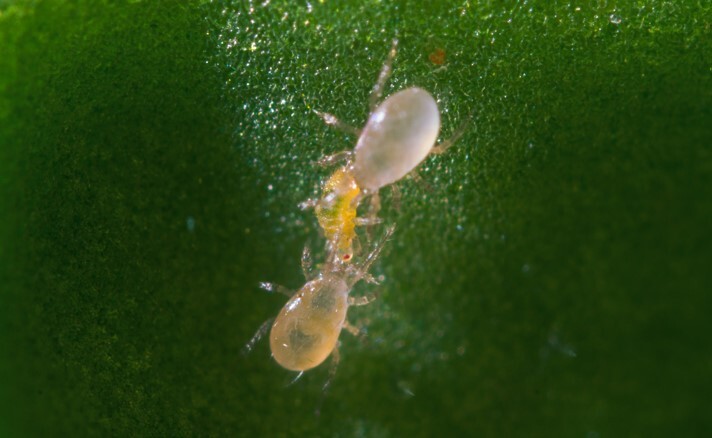What is Amblyseius Swirskii (Swirski-Mite Ulti Mite)?
Amblyseius swirskii is a predatory mite that can be used in the control of a range of problem mites. This predatory mite is ideal for cannabis, vegetables, hardy ornamentals and fruit crops. It targets spider mites species, white fly, thrips, broad mites and russet mites.
Description
Amblyseius swirskii adults have 8 legs and their body is singular, rather than segmented, with under 20 back hairs. A. swirskii cannot be distinguished from a number of other predatory mites of the same genus - such as A. cucumeris, A. californicus, or A. andersoni - with the naked eye. The differences in appearance are subtle and can only be seen under a microscope. The color of A. swirskii is dependent on what the mites have been eating. This canvary from dark red to purple, to light yellow. With thrips and whitefly as prey, the color tends to be a kind of light orange. The mites feed by piercing small arthropod prey or grains of pollen with their mouthparts and draining the contents.
Life Cycle

Adult female mites lay single eggs onto leaf hairs. The mites go through three immature stages: larva, protonymph, and deutonymph, before becoming adults. At 77F, the entire cycle from egg to adult can take less than 7 days. All mobile stages are predatory.
For Best Results
Sachets
Hang from crop wire or immediately below plant canopy
Do not hang adjacent to heating pipes
Duration of sachet activity is 3-6 weeks, though longer-lasting control may be evident if the mites establish in the crop
Shaker Tube (Bulk)
Shake small quantities of Amblyseius swirskii onto the foliage, near base of plant, or...We have found it to be very effective to create multiple release points by distributing bulk product from liter containers into solo cups, with hooks or string, hang these low in the plant’s canopy.
Avoid applying near flowers - the product and its carrier agent will stick to the trichomes.
Introduce Amblyseius swirskii early in the crop cycle to help protect against probelms establishing.
Storage and Transport:
Keep out of direct sunlight
Transport and store at 50F - 59F
Use within 18 hours of receipt
When and where should you use it?
Apply the sachets to any convenient location towards the bottom leaves of the plant, such as a leaf petiole, twig or small branch. In crops grown against supports, or trained along wires, the sachets can be placed on these structures but should always be shaded from direct sunlight.
How should you use it?
For best results, apply the sachets when problem mite numbers are low. The predatory mites will then be able to feed on small colonies of prey and prevent them from growing and causing major damage.
When should you not use it?
Amblyseius swirskii, as with most beneficials, is intended as a preventive treatment. If problem populations are very high, and major damage is visible on the crop, we recommend to start with an alternative treatment, such as essential oils prior to the introduction of Amblyseius swirskii.
What will it do?
Used as directed, Amblyseius swirskii will control or limit problem populations.
What will it not do?
Where problem populations are high at the time of release, control may be slow to occur and damage to the crop will continue. If you have questions about whether you are at a stage that using beneficials would be recommended, please feel free to reach out.
Effective Amblyseuis Swirskii use in Cannbais:
Rates with Amblyseius Swirskii in cannabis seem to vary a little from what the traditional, registered rates would indicate. Instead of treating in meters, and as a row crop, we recommend that each plant have direct attention paid to them, for optimal results. The climate fluctuation and temperature and humidity variations, along with the plant’s rapid growth pattern, necessity to ensure proper air movement, and hairiness/stickiness of the plant all combine to make cannabis a complex and difficult crop to treat.



